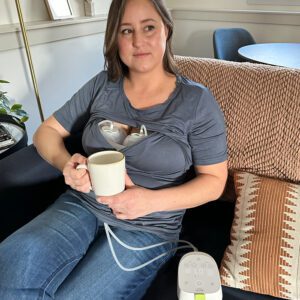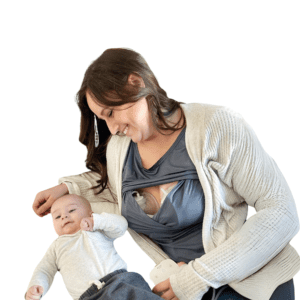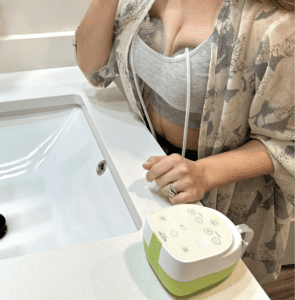משלוח חינם מעל 290 ₪
גיפט כארד – תעניקו אותנו במתנה
משלוח חינם מעל 290 ₪
גיפט כארד – תעניקו אותנו במתנה
דף הבית » מרכז הדרכה למניקות » הורות » שעת הזהב לאחר לידה
In the first hour after birth, the baby goes through several stages, from a state of labor, to crying, to calmness, and then to active alertness. After birth, you will lie in a semi-elevated position between 30 and 45 degrees, enveloped in oxytocin and adrenaline, the baby is skin-to-skin with you, and if given the opportunity, he will also crawl towards your breast, attach himself and begin to suckle.
This is a wonderful window of opportunity for your first breastfeeding in the delivery room, also known as the "golden hour" fastoto.
golden hour
Breastfeeding within the first hour after birth contributes to milk production and a longer breastfeeding period compared to babies who are breastfed for the first time 6 hours or more after birth.
The sense of touch – Using his bare hands, your baby massages your breast. Every time he touches your breast, oxytocin is released, which releases milk.
Sense of smell – Your baby knows the smell of amniotic fluid from the womb and, with the help of his well-developed sense of smell, smells his hands that smell of amniotic fluid and finds the nipples, because the glands in the areola secrete a similar smell. Therefore, it is advisable to postpone the first bath and not remove the amniotic fluid from his hands after birth.
The familiar smell calms him down, he will cry less and it will encourage him to open his eyes and start to latch on to the breast . Even dim light will encourage a sleepy baby to relax, open his eyes and start breastfeeding. After breastfeeding, the baby will return to a deep sleep and wake up each time for short and frequent feedings. In this way, milk production increases. It is not a matter of a lack of milk or that the baby is not getting enough, and there is no need to give additional formula.
You can ask the midwife to help with the connection.
By Julie Karako, IBCLC certified lactation consultant and Tipat Halav nurse. 0506248339
שיתוף הפוסט
קטגוריות
להתייעצות שלחו את פרטיכם
תגיות
מאמרים נוספים

שאיבה בלעדית – טיפים וכל מה שצריך לדעת
אם את שואבת חלב בלעדית – תדעי שאת לא לבד, ואת עושה משהו גדול.רוב האימהות

Power pumping שאיבת אשכולות ardo alyssa
היתרונות בשימוש בשיטת power pumping במשאבת החלב ardo alyssa לעיתים יש צורך בהגברת חלב האם

איך תדעי אם מידת הקונוס/גביע של משאבת החלב מתאימה לך
האם השאיבות מאתגרות אותך את חשה כאבים בזמן השאיבה? מרגישה תחושת מלאות בחזה? או שאת

משאבה ברמת בית חולים – ארדו כארום
מה זו משאבה ברמת בית חולים ישנן משאבות רבות בשוק, אך לא כולן מוגדרות כמשאבות
קטגוריות
In the first hour after birth, the baby goes through several stages, from a state of labor, to crying, to calmness, and then to active alertness. After birth, you will lie in a semi-elevated position between 30 and 45 degrees, enveloped in oxytocin and adrenaline, the baby is skin-to-skin with you, and if given the opportunity, he will also crawl towards your breast, attach himself and begin to suckle.
This is a wonderful window of opportunity for your first breastfeeding in the delivery room, also known as the "golden hour" fastoto.
golden hour
Breastfeeding within the first hour after birth contributes to milk production and a longer breastfeeding period compared to babies who are breastfed for the first time 6 hours or more after birth.
The sense of touch – Using his bare hands, your baby massages your breast. Every time he touches your breast, oxytocin is released, which releases milk.
Sense of smell – Your baby knows the smell of amniotic fluid from the womb and, with the help of his well-developed sense of smell, smells his hands that smell of amniotic fluid and finds the nipples, because the glands in the areola secrete a similar smell. Therefore, it is advisable to postpone the first bath and not remove the amniotic fluid from his hands after birth.
The familiar smell calms him down, he will cry less and it will encourage him to open his eyes and start to latch on to the breast . Even dim light will encourage a sleepy baby to relax, open his eyes and start breastfeeding. After breastfeeding, the baby will return to a deep sleep and wake up each time for short and frequent feedings. In this way, milk production increases. It is not a matter of a lack of milk or that the baby is not getting enough, and there is no need to give additional formula.
You can ask the midwife to help with the connection.
By Julie Karako, IBCLC certified lactation consultant and Tipat Halav nurse. 0506248339

לידיעתך, אתר זה משתמש בקבצי Cookies בין השאר לצורך שיפור חוויית המשתמש, ניתוח ביצועים, והתאמת תכנים ופרסומות. המשך הגלישה באתר מהווה הסכמה לשימוש בקבצי Cookies בהתאם למדיניות שלנו. למידע נוסף והרחבה, עיין/י במדיניות העוגיות ו- במדיניות הפרטיות